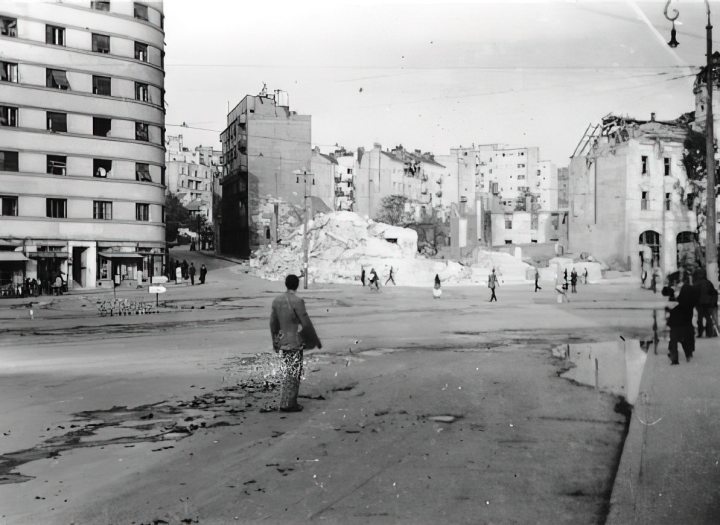On this day 80 years ago, 6 April 1941, my great-grandparents’s flat in Vuka Karadžića street in Belgrade was torn in two by the Nazi bombs. On the same day, their relative, who was a child at the time was almost killed in the debris the Stukas made of an air-raid shelter by the Ascension church. A few days later, as the Kingdom of Yugoslavia was overrun by the Nazi troops and their local collaborators and its shambolic army capitulated, my great-grandfather, escaped being sent to a POW camp by hiding behind a horse-driven cart by the bombed out Central Railway Station.

Those are the stories that I immediately remember on this day, that my grandmother told me remembering what her life as an 8 year old in Belgrade was like. There were many more from the war and the dark, brutal occupation years that followed until 1944. She talked about how my grandfather bought a goat and kept it in the Belgrade fortress to pasture so they could get milk. She vividly remembered the Easter, Allied bombing in 1944 when a small coincidence and change of plans saved her life. Then of course, there were the stories about her Jewish friends who were killed or left the city immediately after the war.
Not all of the family stories about the occupation were from Belgrade based, of course. My paternal grandmother’s family was made to leave Sarajevo (they were not only Serbs, but my great-grandfather was in the, thus a natural target for Ustaše). My paternal grandfather, was put on the list to be executed in Montenegro for being in the early Resistance. Another great-great-granduncle, a merchant from Hrvatska Dubica, almost ended up in Jasenovac, but for his former Croat apprentice, who joined the Ustaše but decided to save his life due to affection for his former Serb boss.
These stories were rarely told in a sombre dark way: they were everyday tidbits of information. Tied to things and places that survived the destruction of WWII in Serbia, or to places that famously didn’t. Whenever a piece of precious china was taken out for an occasion or I was rocking too hard on one of the heavy, uncomfortable armchairs in her flat, or when we went for one of our long walks to explore Belgrade, these stories would pop up. (In retrospect, they are probably the main reason why I became so interested in the stories and people behind places and objects, but I digress).

And of course, they popped up as reminders of how to survive difficult days in 1990s, whether the shortages from the sanctions and hyperinflation, or, most pertinently, the 1999 NATO bombing. These experiences were practical in both the mundane sense (always have some canned food in stock, never focus all your properties in too close a proximity to one another as it may get bombed) , but even more in a more deeper psychological sense of understanding how the world works: nothing is forever, everything you own might the taken away from you, you can find yourself at the mercy of those would gladly annihilate you and your family, you need to survive.

Sadly my grandmother passed away almost 20 years ago, so I am low on very detailed stories, and anyway I do not have that much an exciting family history or wisdom to regale you with, but I decided to try and use this April to write about the life in Belgrade during occupation.
In the past few years there is a lot of interest in exploring this topic, however I found that a lot of it, even if academic, tends to go under the rubric of “mythbusting” rather than understanding what was going on, and some of the research gestures to exculpating the Nazis from their sins by relativising them or passing them on to the collaborators. While the latter did exist of course, both as practical and ideological help to the Nazis, are should be of great interest, where this line of research often fails is trying to portray collaboration as systemic, a very tricky feat given not only the many reprisals the Nazis took on the Serbian population, but also that Serbia, although it had puppet government, was not a state but an occupied territory where none of the leaders and ideologues would be in power were it not for their allegiance to the Nazis.
On the other, hand just talking about the atrocities is something that I am not particularly good at – (although there were many and many of them are forgotten) – so what I find most fascinating are individual stories of people trying to survive in those trying times and the choices they made to do so, given the very fraught and complex situation. One of the best Yugoslav films, Lordan Zafranović’s Occupation in 26 Pictures did that masterfully by following an Italian parvenu, a Croat Communist bourgeois and a Jew in WWII Dubrovnik, and thus I hope that this series (of two to six articles – sadly there are things going in my personal life that prevent me from writing and/or planning) will be a worthy homage, as it follows stories both from collaborators and those trying to live and survive those horrific times.

The Nutshell Times is an independent project and a work of love – but it still requires money to run. If you like the content you can support it on Paypal or Patreon.

